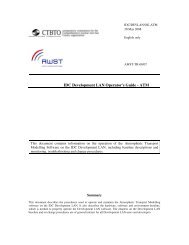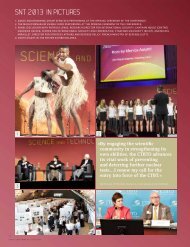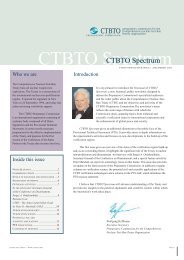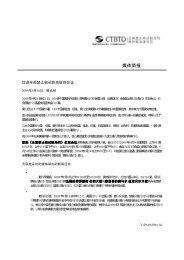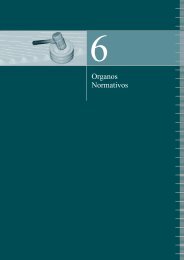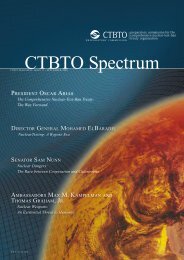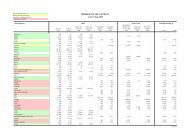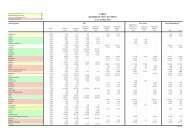Conference Programme - Comprehensive Nuclear-Test-Ban Treaty ...
Conference Programme - Comprehensive Nuclear-Test-Ban Treaty ...
Conference Programme - Comprehensive Nuclear-Test-Ban Treaty ...
You also want an ePaper? Increase the reach of your titles
YUMPU automatically turns print PDFs into web optimized ePapers that Google loves.
PROGRAMMECOMPREHENSIVENUCLEAR-TEST-BANTREATY:SCIENCE ANDTECHNOLOGY2 118–10 JUNEHOFBURG PALACEVIENNA, AUSTRIAIN COOPERATION WITHTHE AUSTRIAN FEDERAL MINISTRY FOREUROPEAN AND INTERNATIONAL AFFAIRSWWW.CTBTO.ORG
OVERVIEW: Wednesday, 8 June 2011Auditoriums Posters ExhibitionGrosserRedoutensaalKleiner RedoutensaalDachfoyerMittlereLounge &FoyerUntereLounge08:00Registration *10:0013:0014:0015:3015:45Opening Ceremonyand Keynote LecturesLunch break (Finger lunch provided)Oral PresentationsTheme 1Oral PresentationsTheme 2Coffee breakThemes 1, 3, 4 and 5Poster SessionTheme 1Posters forPosters for Theme 2Vendor Exhibition16:00Coffee break16:15Oral PresentationsThemes 1 & 4Oral PresentationTheme 218:30-20:00Posters for Tohokuand Fukushima **Reception &Poster SessionTheme 4Reception &Poster SessionTheme 2* At the ground floor entrance area** Posters for Tohoku and Fukushima will be on display in the Grosser Redoutensaal during the conferenceTheme 1: The earth as a complex systemTheme 2: Understanding the nuclear explosion sourceTheme 3: Advances in sensors, networks and observational technologiesTheme 4: Advances in computing, processing and visualization for verification applicationsTheme 5: Creating knowledge through partnerships, training and information/communication technologyTohoku: 11 March 2011 Tohoku Earthquake and subsequent tsunamiFukushima: Fukushima nuclear power plant accident1
OVERVIEW: Thursday, 9 June 2011Auditoriums Posters ExhibitionGrosserRedoutensaalKleinerRedoutensaalDachfoyerMittlereLounge &FoyerUntereLounge09:00 Oral PresentationsTheme 1Oral PresentationsThemes 4 & 510:15Coffee break10:30Coffee break10:45Oral Presentations11:00 Oral PresentationsTheme 1Theme 411:30Panel Discussion 112:30 - Lunch break (Finger lunch provided)- Seminar for Journalists (closed)14:00Panel Discussion 215:00 Break15:15 Oral PresentationsTohokuThemes 1, 3, 4 & 5Poster SessionTheme 3Posters forPosters for Theme 2Vendor Exhibition16:15 Coffee break16:45 Oral PresentationsFukushima17:45Panel Discussion 319:00-20:00Reception andPoster SessionTohoku and FukushimaPanel Discussion 1: Potential mechanisms to conduct studies, partnerships and pilot projects of interest to theCTBTOPanel Discussion 2: Ideas for underlying technology support programmes and possible opportunities for CTBTOexternalresearch and developmentPanel Discussion 3: Fukushima nuclear power plant accident2
OVERVIEW: Friday, 10 June 201109:00GrosserRedoutensaalOral PresentationsTheme 3AUDITORIUMSKleinerRedoutensaalOral PresentationsThemes 1 & 510:3010:45Coffee break11:00Coffee break11:15Oral PresentationsTheme 3 Oral PresentationsTheme 513:0014:00Lunch break (Finger lunch provided)Oral PresentationsTheme 3Oral PresentationsTheme 415:30 Coffee break Coffee breakPOSTERSDachfoyerThemes 1, 3, 4 & 5Poster sessionTheme 5Posters forMittlereLounge &FoyerPosters for Themes 2VENDOREXHIBITIONUntereLoungeVendor Exhibition16:00 Scientific ConcludingSession17:00 ClosingCeremony andReception19:00END OF CONFERENCE3
OPENING SESSION: Wednesday, 8 June 2011, 10:00-1300• WelcomeLASSINA ZERBODirector, International Data Centre (IDC) DivisionProvisional Technical Secretariat of the CTBTO Preparatory Commissionand Project Executive for the CTBT: S&T2011 <strong>Conference</strong>• Children’s Choir of the American International School in Vienna• Keynote lecture“The Scientific Roots and Prospects for the CTBTO and the International Monitoring System "RICHARD L. GARWINIBM Fellow Emeritus• Keynote lecture"Earth and Lunar Science - Interaction Between Basic Science and Public Need"DAVID STRANGWAYPresident Emeritus of the University of British Columbiaand of the Canada Foundation for Innovation• DiscussionModeratorRAYMOND JEANLOZUS National Academy of Sciences and Department of Astronomy and Earth and Planetary Sciences,University of California, Berkeley• Opening remarksHE Dr MICHAEL SPINDELEGGERVice-Chancellor and Federal Minister for European and International AffairsRepublic of Austria• Opening remarksHE Mr TIBOR TÓTHExecutive Secretary of the Preparatory Commission for the <strong>Comprehensive</strong> <strong>Nuclear</strong>-<strong>Test</strong>- <strong>Ban</strong> <strong>Treaty</strong>Organization• MessageHE Mr BAN KI-MOONUnited Nations Secretary-General• Announcements on the <strong>Programme</strong> of Work4
PANEL DISCUSSIONS, Thursday, 9 June 2011Panel Discussion 1: Potential mechanisms to conduct studies, partnerships and pilot projects of interest to the CTBTOModerator:Gerardo Suarez, Research Scientist, Autonomous University of Mexico, Institute of Geophysics, MexicoMembers:1. TIM AHERNDirector, Incorporated Research Institutions for Seismology (IRIS) ServicesUnited States of America2. RONAN LE BRASUnit Head, Software Integration/Scientific Applications,International Data Centre (IDC) DivisionProvisional Technical Secretariat of the CTBTO Preparatory Commission3. BERNARD DOSTHead, Seismology DepartmentRoyal Netherlands Meteorological Institute (KNMI)Netherlands4. MATTHIAS ZAEHRINGERUnit HeadFederal Office for Radiation ProtectionGermanyPanel Discussion 2: Ideas for underlying technology support programmes and possible opportunities for CTBTO-externalresearch and developmentModerator:Kiyoshi Suyehiro, Integrated Ocean Drilling Program, Management International, JapanMembers:1. RANDY BELLDirector, Office of <strong>Nuclear</strong> Detonation DetectionNational <strong>Nuclear</strong> Security AdministrationUS Department of EnergyUnited States of America2. GILLES OLLIERHead of Sector, Earth ObservationManagement of Natural Resources RTD.I.4Research Directorate General, European Union3. ROLAND SCHENKELFormer Director GeneralJoint Research CentreEuropean Union4. ALIK ISMAIL-ZADEHSecretary GeneralInternational Union of Geodesy and GeophysicsPanel Discussion 3: Fukushima nuclear power plant accidentModerator:Susan Watts, British Broadcasting Corporation (BBC), United kingdomMembers:1. MATTHIAS AUERProject Manager - RadionuclideInternational Monitoring System (IMS) DivisionProvisional Technical Secretariat of the CTBTO Preparatory Commission2. DENIS FLORYDeputy Director GeneralDepartment of <strong>Nuclear</strong> Safety and SecurityInternational Atomic Energy Agency3. ROLAND SCHENKELFormer Director GeneralJoint Research CentreEuropean Union4. WOLFGANG WEISSChairman of the 58th and 59th SessionsUnited Nations Scientific Committee on the Effects of Atomic Radiation (UNSCEAR)and Head of the Department of Radiation Protection and HealthFederal Office for Radiation Protection (BfS), Germany5. HARRI TOIVONENDirector of LaboratorySecurity TechnologyRadiation and <strong>Nuclear</strong> Safety Authority (STUK), Finland5
EXHIBITION8-10 JUNE 2011UNTERE LOUNGEVendors1. Geotech Instruments, LLC2. Scientific Production Center “ASPECT”3. Gammadata SAUNA Systems4. Guralp Systems Ltd.5. Ultisat, Inc.6. AMETEK Advanced Measurements Technology Inc. (Ortec)7. Canberra Packard Central Europe GmbH8. ESRi9. Reftek US Refraction Technology10. DigitalGlobe11. Instrumental Software Technologies, Inc. (ISTI)Provisional Technical Secretariat of the CTBTO Preparatory Commission12. Technology Foresight for the CTBT13a. Jobs@CTBTO13b. Investing in the Future: Strengthened Verification, Enhanced Security6
SCIENTIFIC SESSIONSTheme 1. The earth as a complex systemConveners:IVAN KITOVInternational Data Centre (IDC) Division, Provisional Technical Secretariat of the CTBTO Preparatory CommissionROBERT G. PEARCEInternational Data Centre (IDC) Division, Provisional Technical Secretariat of the CTBTO Preparatory CommissionPAUL G. RICHARDSColumbia University Lamont-Doherty Earth Observatory, United States of AmericaInvited Speakers:ELISABETH BLANCCommissariat à l’Energie Atomique (CEA), FranceCATHERINE DEGROOT-HEDLINScripps Institution of Oceanography, Univesity of California, United States of AmericaEMILE OKALDepartment of Earth and Planetary Sciences, Northwestern University, United States of AmericaTheme 2. Understanding the nuclear explosion sourceConveners:MIKA NIKKINENInternational Data Centre (IDC) Division, Provisional Technical Secretariat of the CTBTO Preparatory CommissionMATJAZ PRAHOn-Site Inspection Division, Provisional Technical Secretariat of the CTBTO Preparatory CommissionMARTIN KALINOWSKICentre for Science and Peace Research, University of Hamburg, GermanyInvited Speakers:HARRY MILEYPacific Northwest National Laboratory, United States of AmericaANDERS RINGBOMSwedish Defence Research Agency (FOI), SwedenHARRI TOIVONENSecurity Technology, Radiation and <strong>Nuclear</strong> Safety Authority (STUK), FinlandTheme 3. Advances in sensors, networks and observational technologiesConveners:PATRICK GRENARDInternational Monitoring System Division, Provisional Technical Secretariat of the CTBTO Preparatory CommissionMATTHIAS AUERInternational Monitoring System Division, Provisional Technical Secretariat of the CTBTO Preparatory CommissionJOHN BERGERScripps Institution of Oceanography, United States of AmericaInvited Speakers:MICHEL ANDRÉTechnical University of Catalonia, SpainDAVID SIMPSONIncorporated Research Institutions for Seismology (IRIS), United States of America7
SCIENTIFIC SESSIONS (cont.)Theme 4. Advances in computing, processing and visualization for verification applicationsConveners:JEFFREY GIVENInternational Data Centre (IDC) Division, Provisional Technical Secretariat of the CTBTO Preparatory CommissionDAVID BOWERSAWE Blacknest, United KingdomSTUART RUSSELLComputer Science Division, University of California, United States of AmericaInvited Speakers:ROBERT JONESEuropean Organization for <strong>Nuclear</strong> Research (CERN), SwitzerlandTheme 5. Creating knowledge through partnerships, training and information/communication technologyConveners:JERRY CARTERInternational Data Centre (IDC) Division, Provisional Technical Secretariat of the CTBTO Preparatory CommissionJOHN COYNEInternational Data Centre (IDC) Division, Provisional Technical Secretariat of the CTBTO Preparatory CommissionDMITRY STORCHAKInternational Seismological Centre (ISC), United KingdomInvited Speakers:JOSÉ ACHACHEGroup on Earth Observations (GEO), SwitzerlandCHRISTINE WINGCenter on International Cooperation, University of New York, United States of AmericaTohoku and FukushimaConveners:SPILIO SPILIOPOULOSInternational Data Centre (IDC) Division, Provisional Technical Secretariat of the CTBTO Preparatory CommissionKIYOSHI SUYEHIROIntegrated Ocean Drilling Program, Management International, JapanEMILE OKALDepartment of Earth and Planetary Sciences, Northwestern University, United States of America8
ORAL PRESENTATIONS: Wednesday, 8 June 2011, AfternoonRoom: Grosser RedoutensaalRoom: Kleiner Redoutensaal14:00 T1-O2. Rupture dynamics of large earthquakes inferred14:15from hydroacoustic dataCatherine de Groot-Hedlin14:30 T1-O9. Next-level shake zoning for modeling seismicwavepropagation in the U.S. Intermountain WestJohn N. Louie14:45 T1-O10. Ground motion studies for critical sites in northeast<strong>Ban</strong>gladeshTahmeed Malik Al-Hussaini, M.Nayeem Al-Noman15:00 T1-O11. Prediction of aftershocks distribution usingartificial neural networksMostafa AllamehZadeh15:15 T1-O13. Seismicity and seismic hazard assessment of thearid western regions of South AfricaHlompho Malephane15:30 T1-O14. Crustal thickness and average VP/VS ratiovariations in northern Viet Nam from teleseismic receiverfunction analysisVan Duong Nguyen, Bor-Shouh Huang, Tu-Son Le, Van-Toan Coffee breakDinh15:45Theme 2 Introductory RemarksMr Oleg RozhkovDirector, On-Site Inspection Division, CTBTOT2-O1. Understanding the radionuclide source term forunderground nuclear explosionsHarry MileyT2-O2. The global atmospheric noble gas backgroundAnders RingbomT2-O12. Medical isotopes studiesJudah Friese, Rosara Payne16:00 Coffee breakT2-O10. Temporal evolution of the radioxenon signaturefrom underground nuclear explosionsMartin Kalinowski16:15 T1-O15. Scattering and intrinsic attenuation structure inCentral Anatolia, Turkey using BRTR (PS-43) array dataKorhan Umut Semin, Nurcan Meral Ozel16:30 T1-O16. Detection of earthquake hazard in southwestpeninsular India – Spurt of various unusual geologicalincidentsD. Shanker, H. N. Singh, John Matha, V. N. Neelakandan, A.Kumar16:45 T1-O17. Upper crust structure under CTBTO station“Petropavlovsk-Kamchatsky” by endogenic microseismicactivityYulia Kugaenko, Vadim Saltykov, Victor Chebrov17:0017:15T4-O1. Distributed e-infrastructures for data intensivescienceRobert Jones17:30 T4-O8. Anomalous infrasound propagation through thedynamic stratosphereLäslo Evers, Anton Van Geyt, Pieter Smets, Julius Fricke17:45 T4-O12. Analysis of classification possibility infrasoundT2-O6. Analysis of fission products in air samples due tonuclear explosion sourceAbdus Sattar MollahT2-O9. Effects of non-isotropic explosion sources uponthe utility of the Ms-mb discriminantPaul G. RichardsT2-O4. Numerical experiments on explosions triggeringearthquakesLuis Angel Dalguer, Florian Haslinger, Seok Goo Song, TarjeNissen-Meyer, Domenico GiardiniT2-O7. Modelling of elastic waves generated by a pointexplosionZurab Kereselidze, Nino TsereeliT2-O11. Seismo-acoustic energy partitioning fromshallow and surface explosionsJessie Bonner et al.T2-O8. The source time function of an explosive sourceAnton Ziolkowskisignals from different sources based on correlation abilityT2-O3. New and novel technologies for CTBT radionuclideSergey Kulichkov, Alexei Chulichkov, Nadezhda Tsybulskaya18:00 T4-O10. A statistical framework for operational infrasoundmonitoringStephen Arrowsmith, Rod Whitakermeasurement and analysisHarri Toivonen18:15 T2-O13. The IAEA Department of Safeguards: Crossovernovel technologiesAndrew Monteith, Julian Whichello9
ORAL PRESENTATIONS: Thursday, 9 June 2011, MorningRoom: Grosser Redoutensaal09:00 T1-O1. Infrasound: from explosion monitoring toatmospheric studies and climateElisabeth BlancRoom: Kleiner RedoutensaalT5-O3. Transnational cooperation: What and why?Christine Wing09:30 T1-O4. Monitoring of explosive volcano eruptions inKamchatka and the Kuriles Islands on acoustic datafrom IMS and KBGS RAS stationsEvgenii I. Gordeev, Evgenii R. Makhmudov, Pavel P. Firstov,Sergei N. Kulichkov, Viktor N. Chebrov09:4510:0010:15T1-O5. Civil applications of CTBT verification softwareand technologies: Volcano eruption in IcelandGerhard Wotawa, Ulrike MitterbauerT1-O6. Determination of an uncertainty radius forback tracing infrasound signals to source caused byatmospheric wave activitySabine Wüst, Christoph Pilger, Verena Kopp, Michael BittnerCoffee breakT5-O4. Capacity building in the context of the<strong>Comprehensive</strong> <strong>Nuclear</strong>-<strong>Test</strong>-<strong>Ban</strong> <strong>Treaty</strong>Lassina Zerbo, John Coyne, Belkacem DjermouniT4-O4. Bayesian inference for the study of low-levelradioactivity in the environment: Application to thedetection of xenon isotopes of interest for the CTBTOIsabelle Rivals, Xavier BlanchardT4-O9. On the potential of public available griddedprecipitation re-analysis and monitoring products toaccess the wet-deposition impact on PTS radionuclidemonitoring capabilityAndreas Becker, Ole Ross, Lars CerannaT4-O6. NET-VISA model and inference improvementsNimar Arora, Stuart Russell, Paul Kidwell, Erik Sudderth10:30Coffee break10:45T1-O3. Extracurricular geophysics, or tsunamis in the11:00 complex earth systemT4-O3. Improving regional seismic travel times (RSTTs)Emile Okalfor more accurate seismic locationStephen Myers et al.11:15T1-O7. Argon 37: What is the suspicious thresholdactivity in soil air?Roland Purtschert, Robin Riedmann10
ORAL PRESENTATIONS: Thursday, 9 June 2011, AfternoonRoom: Grosser RedoutensaalRoom: Kleiner Redoutensaal15:15 JS-O1. Source process and broadband waveformmodeling of 2011 Tohoku earthquake using Spectral-Element MethodSeiji Tsuboi, Takeshi Nakamura, Akiko To15:30 JS-O2. Magnitude determination using duration of highfrequency energy radiation for the 2011 Off the PacificCoast of Tohoku EarthquakeTatsuhiko Hara15:45 JS-O4. Tsunami infrasound: 2004 Sumatra and 2011Tohoku case studiesMilton Garces et al.1600JS-O6. A window into the complexity of the dynamicrupture of the 2011 Mw 9 Tohoku-Oki earthquakeLingsen Meng, Asaf Inbal, Jean-Paul Ampuero16:1516:30 Coffee break16:45 JS-O3. Analysis of the Fukushima accident by the FrenchNational Data CentreGilbert Le Petit et al.17:00 JS-O5. Canadian monitoring of Fukushima incidentIan Hoffman et al.17:15 JS-O7. Detection of elevated Xe-133 following theFukushima nuclear accidentTed Bowyer et al.17:30 JS-O8. Response of the Austrian Meteorological andGeophysical Service and the National Data CentreAustria to the nuclear accident in Fukushima:Atmospheric transport modelling and situationassessment based on CTBTO radionuclide dataGerhard Wotawa, Ulrike Mitterbauer17:45 JS-O9. Operational experience of CTBTO related to theFukushima nuclear accident and long term perspectivesMika Nikkinen et al.11
ORAL PRESENTATIONS: Friday, 10 June 2011, MorningRoom: Grosser RedoutensaalRoom: Kleiner Redoutensaal09:00 Theme 3 Introductory RemarksMr Federico GuendelDirector, International Monitoring System (IMS) Division,CTBTO09:15T1-O8. The South Sarigan submarine volcanic eruption,May 2010: an example of International MonitoringSystem waveform data synergy.David Green et al.T1-O12. Neural classification of infrasonic signals fromhazardous volcanic eruptionsGarces et al.T3-O1. Integrated solutions for a sustainabledevelopment of the offshore industry: live monitoring09:30 of noise and acoustics eventsT5-O10. Ghana’s experience in the establishment of aMichel André et al.National Data CentrePaulina Ekua Amponsah, Yaw Serfor-Armah09:45T5-O11. Creating knowledge and building capacity inUgandaT3-O2. Open data resources and sharedCynthia Ayeroinstrumentation facilities to support research in10:00 seismologyT5-O12. A CTBT implementation process in Panama toDavid Simpsonforge broader partnershipsMiguel Gonzalez Marcos, Omayra Perez Castro, BernardoFernandez Garcia10:1510:3010:45T3-O5. The Optical Seismometer – a new technologyfor seismographic observationsJonathan BergerCoffee breakT5-O5. Educational outreach as a capacity developmentstrategy, using the Irish example, seismology in schools,Dublin Institute for Advanced Studies (DIAS) Outreach<strong>Programme</strong>Thomas Blake, Grace CampbellT5-O9. Infrasound calibration in the EasternMediterraneanJohn Coyne et al.11:00 T3-O7. The Optical Fiber Infrasound Sensor –improved wind noise reductionJonathan Berger, Mark Zumberge11:15 T3-O13. Measuring mesopause temperatureperturbations caused by infrasonic waves - Aninnovative sensor approachMichael Bittner, Kathrin Höppner, Christoph Pilger, CarstenSchmidt11:30 T3-O12. The EarthScope USArray Transportable Array:Results from large-scale network operationsRobert Woodward, Robert Busby, Katrin Hafner, DavidSimpson11:45 T3-O3. Challenges and growth for NEPTUNE CanadaLucie Pautet, Christopher R. Barnes, Fern Johnson, Mairi M.R. Best, Benoit Pirenne12:00 T3-O6. Data for OSI multi-spectral and infraredinstrument developmentJohn Henderson, Milton Smith, Michael Zelinski12:15 T3-O8. A new underground radionuclide laboratory -RL16Joel Forrester, Craig Aalseth, Larry Greenwood, Harry Miley,Cory OvermanCoffee breakT5-O1. The global earth observation system of systemsJosé Achache, Francesco GaetaniT5-O7. The IMS network and the International Federationof Digital Seismograph Networks FDSN - a long andwinding roadGerardo Suarez, Florian HaslingerT5-O6. CTBTO contribution to the global earthquake datacollection: a view from the International SeismologicalCentre (ISC)Dmitry A. Storchak, Istvan Bondár, James Harris, Ben DandoT5-O8. Contributions of the scientific community to CTBTmonitoring and verificationMartin Kalinowski12:30 T5-O13. Methodology for on-site inspections and lessonslearned from different verification regimesYousry Abushady12
ORAL PRESENTATIONS: Friday, 10 June 2011, AfternoonRoom: Grosser Redoutensaal14:00 T3-O10. Production of Xe standards for the calibrationof noble gas sampler stations and laboratoryequipmentKari Peräjärvi et al.14:15 T3-O11. Xenon diffusion reduction using surfacecoatings on plastic scintillators in beta-gammacoincidence detection systemsLisa Bläckberg et al.14:30T3-O4.The effectiveness of radionuclide monitoring:assessed with a natural airborne tracerMurray MatthewsRoom: Kleiner RedoutensaalT4-O2. Improved signal detection at seismometerarraysNeil SelbyT4-O7. Real-time global seismic wave propagation andnon-linear inversion for source and structureTarje Nissen-Meyer, Alexandre Fournier, P. Martin Mai,Florian Haslinger, Domenico GiardiniT4-O13. High resolution array processing forearthquake source studies at regional distanceLingsen Meng, Jean-Paul Ampuero14:45T3-O9. Figure of merit for choosing Xe backgroundstudy locationsPaul Eslinger, Derek Haas, Harry MileyT4-O11. Reliable Lg arrival time picks and potential forenhanced epicenterEystein S. Husebye, Tatiana Matveeva15:00T3-O14. Optimal design of a noble gas monitoringnetworkIan Hoffman et al.15:15 T3-O15. Potential of the International MonitoringSystem (IMS) radionuclide network for inversemodelingMohammad Reza Koohkan, Lin Wu, Marc Bocquet, MonikaKrystaT4-O5. Improvements to seismic monitoring of theEuropean Arctic using three-component arrayprocessing at SPITSSteven J. Gibbons, Johannes Schweitzer, Frode Ringdal,Tormod Kvaerna, Svein Mykkeltveit13
POSTER SESSION: Wednesday, 8 June 2011, 13:00-14:00, DachfoyerTheme 1. The earth as a complex systemT1-P1. Tsunami numerical simulation applied to tsunami early warning system along Sumatra regionWiko SetyonegoroT1-P2. Seismic hazard assessment for Zambia and surrounding areasGift ChafwaT1-P3. Evidence for infragravity wave-tide resonance in deep oceansHiroko Sugioka, Yoshio Fukao, Toshihiko KanazawaT1-P4. Hydro-tremors and incidence of ground rupturing in the northern parts of India: A plausible modelDaya Shanker, M. <strong>Ban</strong>erjee, H. N. Singh, Sanjay, U. S. SinghT1-P5. Shallow structure study using gravity dataAgustya Adi MarthaT1-P6. Analysis spatial and temporal b-value variability seismicity north of SulawesiJimmi NugrahaT1-P7. Seismic anisotropy from IDC dataGoetz BokelmannT1-P8. The RN50 station of the International Monitoring System (IMS) as a reference station to the airborne particlespollution in Panama CityOmayra Perez CastroT1-P9. Observations of acoustic-gravity waves in the Czech RepublicTereza Sindelarova et al.T1-P10. Detection and identification of low-magnitude seismic events near Bala, central TurkeyKorhan Umut Semin, Nurcan Meral Ozel, Ocal NecmiogluT1-P11. Source effects vs. site effects of Vrancea earthquakes recorded in RomaniaAndrei Bala, Mircea Radulian, Bogdan GrecuT1-P12. Geophysical investigation for lake level riseBerihun Asfaw AreggaT1-P13. Atmospheric transport processes over the Kathmandu valley, NepalRam Prasad Regmi, Lok Narayan JhaT1-P14. 1-D Velocity model for use by the SANSN in earthquake locationVunganai Midzi, Ian Saunders, Martin Brandt, Timothy MoleaT1-P15. Determining of the contrast zones based on the analysis of microseismic noiseSvetlana Kishkina, Alexander SpivakT1-P16. Tectonic stress field and recent movements of the earth’s crust in the Manila subduction zone and adjacentfaultsVan Dinh Quoc, Duong Nguyen Van, Luong Nguyen VanT1-P17. Sensitivity analysis of infrasound based source verification: influences of atmospheric conditions and surfaceorographyChristoph Pilger, Florian Streicher, Michael BittnerT1-P18. Detection, location and screening of seismic, hydroacoustic, infrasound and tsunami waveforms associatedwith May 29, 2010 S-Sarigan submarine volcano eruption, Marianas islandsJacques Talandier, Olivier Hyvernaud, Dominique Reymond, Hélène Hébert, Alexis Le PichonT1-P19. Dissipated energy by S-Sarigan paroxysmic eruption and explosive discrimination on hydroacoustic waveformsJacques Talandier, Jean Marc Guérin, Olivier HyvernaudT1-P20. Infrasound studies of some local and regional events detected by I33MGFanomezana Randrianarinosy, Gerard RambolamananaT1-P21. Acoustic observations of stratospheric solar tides: Examples from the eruption of Eyjafjallajökull, Iceland,April-May 2010David Green, Julien Vergoz, Robin Matoza, Alexis Le PichonT1-P22. Adaptively parameterized surface wave tomography: Methodology and a global model of the upper mantleLapo Boschi, Julia Schaefer, Eduard KisslingT1-P23. Unexpected high seismic activity observing near the Ulaanbaatar area, capital city of Mongolia: Improvedrelocation by using array-based earthquake location techniqueUlziibat MunkhuuT1-P24. Vp/Vs ratio and seismic activity at active structure of Ulaanbaatar area, the capital city of MongoliaDemberel SodnomsambuuT1-P25. Investigating body wave energy in ambient seismic noiseMoira Pyle, Keith KoperT1-P26. Characterization of the Carancas meteor fall from infrasound signalsC. Millet, C. P. Haynes Millet14
POSTER SESSION: Wednesday, 8 June 2011, 13:00-14:00, DachfoyerTheme 1. The earth as a complex system (cont.)T1-P27. The OGS local virtual seismic network in South-Central Europe as an array: exploiting depth phases to locateupper mantle discontinuitiesGeorge Helffrich, Damiano Pesaresi, Takashi TonegawaT1-P28. Observations of atmospheric radionuclide cycles: The benefit for global paleoclimate studiesChristoph Elsässer et al.T1-P29. Effect of anisotropic inhomogeneities in the atmosphere on long-range sound propagation from explosionsElena Golikova, Igor Chunchuzov, Sergey Kulichkov, Oleg PopovT1-P30. Comparison of recurrence curves from the IDC and ISC catalogsIvan Kitov, Dmitry Bobrov, John Coyne, Robert PearceT1-P31. Inverse modelling of the 2010 Eyjafjallajökull eruption and comparison with infrasound signalsPetra Seibert et al.T1-P32. Using the International Monitoring System infrasound network to study large-scale atmospheric wavesJulien Marty, Francis DalaudierT1-P33. Remote monitoring of volcanic eruptions using the International Monitoring System infrasound networkAmy Dabrowa, David Green, Jeremy Phillips, Alison RustT1-P34. Infrasound propagation in the atmosphereDmitriy GolikovT1-P35. Explosion of crater lake in the “Cameroon line” area: seismic contributionParfait Noel Eloumala OnanaT1-P36. Computation of pressure change in the sea from acoustic and tsunami waves excited by a sub-oceanicearthquake with a finite-difference scheme for seismic wavesHiroshi Takenaka, Toshihiro Kuramoto, Takeshi Nakamura,Taro Okamoto, Genti ToyokuniT1-P37. Environmental impact of the nuclear tests in ArgentinaEduardo QuintanaT1-P38. Evaluating 238U/235U in U-bearing accessory mineralsJoe Hiess et al.T1-P39. Time series analysis of the seismic events worldwideJun-Hee Lee, John CoyneT1-P40. Phase velocity and attenuation parameters in the Iranian PlateauReza Rezaei, Ali SafepourT1-P41. Do triggered earthquake patterns depend on trigger faulting style?Mohammad Tahir, Jean Robert GrassoT1-P42. The physics of tsunami: basics understanding and its disastrous effectsD. ShankerT1-P43. Assessment of tsunami damage using remote sensing and GIS and expected benefits of disaster early warningsystems to tsunami vulnerable areasOscar Kithsiri Dissanayake Mudiyanselage DonT1-P44. Seismic monitoring in Azerbaijan in aspects of seismic hazard assessmentGulam Babayev, Fakhraddin GadirovT1-P45. The ARISE projectElisabeth Blanc et al.T1-P46. A report of natural background radiation hazard in southern Tamil Nadu, India and its effect on habitat andenvironmentDaya Shanker, H. N. Singh, V. N. Neelakandan, A. KumarT1-P47. Forecast of the earthquakes’ aftershocks in the common operations of seismic risk reductionFarshed Karimov15
POSTER SESSION: Wednesday, 8 June 2011, 18:30-20:00, Mittlere Lounge & FoyerTheme 2. Understanding the nuclear explosion sourceT2-P1. Application of geophysical methods while revealing UNE signatures at Semipalatinsk <strong>Test</strong> Site (for OSI purposes)Andrey Belyashov, Victor Shaitorov, Mikhail YefremovT2-P2. A near-regional verification analysis of North Korean nuclear testsKin-Yip ChunT2-P3. Contribution of isotopes production facilities and nuclear power plants to Xe-133 worldwide atmosphericbackgroundPascal Achim, Gilbert Le PetitT2-P4. Study on underground vacancy detection based on vertical gravity gradient measurementsQingbin Wang, Dong Jiang, Yin Chen, Dongming ZhaoT2-P5. Spectral ratios of regional phases recorded at the Dongbei Seismic Network for the North Korean explosions in2006 and 2009Hans Israelsson, Kin-Yip ChunT2-P6. CTBT related activities of Turkish National Data CenterNurcan Meral Ozel et al.T2-P7. Features of geomagnetic anomaliesDmitry A. Sagarаdze, Natalia V. RachkovaT2-P8. Discrimination of natural earthquakes and artificial explosions in 2010, North KoreaYun Kyung Park, Sung Tae Nam, Young Woong KimT2-P9. Tritium in the air as an indicator of nuclear testing venuesSergey Lukashenko, Oxana LyakhovaT2-P10. Design based approach to OSI sampling strategyAntonietta Rizzo, Paolo BartolomeiT2-P11. <strong>Nuclear</strong> test fall-out determination by plutonium isotopic compositionDalis Baltrunas, Andrius Puzas, Ruta Druteikiene, Vidmantas RemeikisT2-P12. Finding and identifying radioactive material by carborne search for OSI deploymentTheo Köble et al.T2-P13. The use of explosion aftershock probabilities for on-site inspection planning, deployment, and reportingSean Ford, Peter Labak, Gideon Leonard, Albert Smith, Jerry SweeneyT2-P14. Analysis and modeling of shear waves generated by explosions at the San Andreas Fault Observatory at depthJustin L. Rubinstein, Fred Pollitz, William L. EllsworthT2-P15. Emerging science for nuclear test monitoringJoanna Ingraham, Justin McIntyreT2-P16. On-site inspection strategy for subsurface detection of noble gases from an underground nuclear testCharles R. Carrigan, Yunwei Sun, Gardar JohannessonT2-P17. Analysis into the evolution of radionuclide inventory with time for some scenarios of nuclide migration into theatmosphere after a nuclear testAndrey UstselemovT2-P18. Proficiency test program for CTBT radionuclide laboratories: An updateEmerenciana Duran, Kirill Khrustalev, Matthias AuerT2-P19. Proposal for an information-led search logic during an on-site inspectionGeorge W. Tuckwell, Luis R. Gaya-PiquéT2-P20. Barkhan (Baluchistan) earthquakes of June 26 and July 12, 1999: Source process from teleseismic body wavesMohammad Tahir, Tariq Mahmood TaiqT2-P21. Exploitation of the IMS and other data for a comprehensive, advanced analysis of the North Korean nuclear testsBenjamin Kohl, John R. Murphy, Jeffry Stevens, Theron J. BennettT2-P22. Stable coda estimates from P and S codas at regional and near-teleseismic distancesKevin MayedaT2-P23. Unstructured grid simulation of the atmospheric pressure-driven subsurface xenon-tracer transportRobert Annewandter, Karen Schmid16
POSTER SESSION: Thursday, 9 June 2011, 12:30-14:00, DachfoyerTheme 3. Advances in sensors, networks and observational technologies (cont.)T3-P1.T3-P2.T3-P3.T3-P4.T3-P5.T3-P6.T3-P7.T3-P8.T3-P9.Characterization of 2010 Mentawai earthquake based on source mechanism analysis by using regional and CTBTmonitoring stationSugeng Pribadi, Nanang T. Puspito, Hendar GunawanAnalysis of the first arrival of P-wave of Ina-TEWS and CTBT stations to support earthquake early warningHendar Gunawan, Gunawan Ibrahim, Sugeng PribadiDetection of tsunami and T-phase by the Dense Oceanfloor Network System for Earthquakes and Tsunamis DONETSeiji Tsuboi et al.A technique to determine the self-noise of seismic sensors for performance screeningHorst Rademacher, Darren Hart, Cansun GuralpSeismic noise analysis at some broadband stations of Egyptian National Seismological NetworkAbd El-Aziz Khairy Abd El-AalImprovement of the equipment for measurements of atmospheric xenon radionuclidesSergei Pakhomov, Yuri DubasovUsing the Garni IMS auxiliary station records in operation of the next-generation real-time seismic intensitydisplay system in ArmeniaValery ArzumanyanSeismic networking in the south Pacific regionFaatali Malaefatu Leavasa, Lameko TaliaDeveloping a block diagram for the earthquake warning deviceKonstantin Kislov, Valentin GravirovT3-P10. New tiltmeter developed in Institute of Physics of the Earth of the Russian Academy of SciencesSergey Matcievsky, Igor Vasilev, Valentin GravirovT3-P11. Superbroadband seismometer for seismomonitoring networks and a tsunami notification serviceSergey Matcievsky, Valentin Gravirov, Konstantin KislovT3-P12. Modelling global seismic network detection thresholdMark Prior, David BrownT3-P13. Equipment testing for IMS waveform technologiesYuri Starovoit, Patrick Grenard, Georgios Haralabus, Darren Hart, Peter MelicharT3-P14. The IDC seismic, hydroacoustic and infrasound global low and high noise modelsDavid Brown, Lars Ceranna, Pierrick Mialle, Mark Prior, Ronan Le BrasT3-P15. Long term - real time background noise monitoring around BR235Nurcan Meral Ozel et al.T3-P16. Bayesian waveform inversion for moment tensors of local earthquakes in the Pannonian basinZoltán WéberT3-P17. Romanian infrasound structure: design and data processingConstantin Ionescu, Daniela GhicaT3-P18. Analysis of the background noise at the auxiliary seismic station Muntele RosuDaniela Ghica, Bogdan Grecu, Constantin Ionescu, Mihaela PopaT3-P19. The GSN data quality initiativeKent AndersonT3-P20. Transportable Xenon LaboratoryTimothy Stewart, Robert Thompson, Harry MileyT3-P21. Towards an effective on-site inspection – A geophysical viewKristof L. Kakas, Tibor Guthy, Endre HegedűsT3-P22. Ionospheric detection of the recent North Korean underground nuclear testJihye Park, Dorota A. Grejner-Brzezinska, Yu (Jade) Morton, Ralph R.B. von Frese, Luis R. Gaya-PiquéT3-P23. Infrasound monitoring of explosive eruptions at Shinmoe volcano in JapanHee-Il Lee, Il-Young CheT3-P24. Development of the IMS facilities, experimental seismic and infrasound observation in UkraineIgor Kachalin, Aleksander LiashchukT3-P25. Real time seismic monitoring in South-Central Europe: data sharing, cooperation and improvements of the OGSNI Seismic NetworkDamiano Pesaresi, Nikolaus Horn, Pier Luigi Bragato, Giorgio DurìT3-P26. The “Hellenic Unified Seismological Network-HUSN”: its implication in the accurate monitoring of the seismicityin the broader area of Aegean SeaDimitrios Papanastassiou, Christos Evangelidis, Kostantinos MakropoulosT3-P27. Studies of vibrations from wind turbines in the vicinity of the Eskdalemuir (AS104) IMS stationSam Toon, Rachel Westwood, Peter Styles17
POSTER SESSION: Thursday, 9 June 2011, 12:30-14:00, DachfoyerTheme 3. Advances in sensors, networks, and observational technologies (cont.)T3-P28. Re-analysis of noble gas samples from IMS stations at laboratories – a review of the results since 2007Herbert GohlaT3-P29. Development of a cosmic veto device to improve detection limits of CTBT detectorsJonathan Burnett, Ashley DaviesT3-P30. SAUNA - Equipment for low level measurement of radioactive xenonHelena BerglundT3-P31. Integrating infrasonic arrays into the Utah Regional Seismic NetworkRelu Burlacu, Kristine L. Pankow, Keith Koper, Brian W. Stump, Chris HaywardT3-P32. Gamma radiation survey techniques for on-site inspectionXiaoyuan Han, Mingyan Jia, Huibin Li, Tiancheng FengT3-P33. Analysis of network QA/QC and Level 5 samples at certified laboratoriesDongmei HanT3-P34. Mobile radiation measurements for on-site inspectionsMika Nikkinen, Markku KettunenT3-P35. AXS: A xenon sampler aiming at long-time stabilityShan Wu, Zhanying Chen, Changyun ZhangT3-P36. Possible improvements of the detection capability of the CTBT monitoring system using active Comptonsuppression techniquesMika Nikkinen et al.T3-P37. Operation of the International Monitoring System networkTimothy Daly, Staff IDC/Operations SectionT3-P38. Design challenges for a noble gas samplerGregory FeuchtT3-P39. A new vision on data acquisition and processingAli Safepour, Reza RezaeiT3-P40. Soccoro Island’s IMS T-stations record the modification of the strain field due to the passage of tsunamisAlexander Poplavskiy, Ronan Le BrasT3-P41. Can OSI use off the shelf techniques?Mordechai Melamud, Luis R. Gaya-PiquéT3-P42. Miniature optical seismic sensors for monitoring applicationsCaesar GarciaT3-P43. Technology foresight for the Provisional Technical Secretariat of the CTBTOPatrick Grenard, Philippe SteeghsT3-P44. GCI-II: How CTBT data is transmitted around the globeJames CrichtonT3-P45. Coseismic tectonomagnetic signals as a tool for seismic risk reductionFarshed KarimovT3-P46. Development of CZT pixel detectorsMichael FiederleT3-P47. Earthworm: A powerful and open-source real-time earthquake and infrasound monitoring software toolSidney Hellman, Paul Friberg, Ilya Dricker, Stefan LisowskiT3-P48. Exploring the potential of satellite imagery for CTBT verificationGopalaswamy, Irmgard NiemeyerT3-P49. IS42: A new IMS certified infrasound station in the Graciosa Island, Azores, PortugalNicolau Wallenstein et al.18
POSTER SESSION: Wednesday, 8 June 2011, 18:30-20:00, DachfoyerTheme 4. Advances in computing, processing and visualization for verification applicationsT4-P1. Network performance of the CTBT monitoring regimeJerry Carter et al.T4-P2. A system for automatic detection of seismic phases in high noise conditionsValentin Gravirov, Konstantin KislovT4-P3. Comparison of regional seismic phases interpretation in REB and KazNDC bulletinsZlata Sinyova, Natalya MikhailovaT4-P4. Focal depth estimation through polarization analysis of the Pn codaEystein S. Husebye, Tatiana MatveevaT4-P5. Evaluating OSI aftershock monitoring efficiencyMikhail Rozhkov, Alexander Kushnir, Alexander VarypaevT4-P6. Automatic clustering of seismic events in an on-site inspection scenarioBenjamin Sick, Manfred JoswigT4-P7. Large earthquakes’ secondary phenomena and their space-ground geodata assessmentFarshed Karimov, Mirzo SaidovT4-P8. Fuzzy ARTMAP: A neural network for fast stable incremental learning and seismic event discriminationEl Hassan Ait Laasri, Es-Saïd Akhouayri, Dris Agliz, Abderrahman AtmaniT4-P9. Application of detection probabilities in the IDC Global Phase Association ProcessTormod Kvaerna, Frode Ringdal, Jeffrey GivenT4-P10. Radioxenon analysis methods and atmospheric transport modelling to distinguish civilian from nuclear explosionsignalsMichael SchoeppnerT4-P11. Listening to the SEL: is the ear easier to train than the eye?Heidi Anderson Kuzma, Emerson ArehartT4-P12. Explanation of the nature of coherent low-frequency signal sources recorded by the monitoring station networkof the NNC RKAlexandr Smirnov, Vitaliy Dubrovin, Läslo G. Evers, Steven J. GibbonsT4-P13. Assessing the improvement capabilities of a generative model 3C-station detector algorithm for the IMSCarsten RiggelsenT4-P14. Real time cross correlation estimated program and its application to processing seismic dataEs-Saïd Akhouayri, El Hassan Ait Laasri, Dris Agliz, Abderrahman AtmaniT4-P15. Advances in kernel-based classification of IMS hydroacoustic signalsMatthias Tuma, Christian Igel, Mark PriorT4-P16. Stockwell transform fingerprints of earthquake waveformsMatthew J. Yedlin, Yochai Ben HorinT4-P17. Travel time corrections via local regressionChristopher Lin, Stuart RussellT4-P18. Challenges of infrasound analysis in IDC operationsPaulina Bittner et al.T4-P19. Signal-based Bayesian monitoringStuart Russell, Nimar Arora, Stephen Myers, Erik SudderthT4-P20. Threshold based algorithms for iron buried objects detection using magnetic field mappingAbdelhalim Zaoui, Saïd Mitt, Amar MesloubT4-P21. Categorization of infrasound detectionsPierre Gaillard, Julien Vergoz, Alexis Le PichonT4-P22. Metrics to determine the effectiveness of computer learning and data mining algorithms developed to aidautomatic processing at the International Data Centre (IDC)Heidi Anderson Kuzma, Ronan J. Le BrasT4-P23. Case study of adding an F-trace algorithm to GeotoolVera Miljanovic, Jeffrey Given, David BowersT4-P24. Analysis of the representativeness of backward atmospheric transport modelling at different resolutions at theTakasaki RN38 IMS stationDelia Arnold, David Pino, Arturo Vargas, Petra SeibertT4-P25. Contribution to the study of seismic background noise application to the region of AgadirAbderrahman Atmani, Es-saïd Akhouayri, Driss Agliz, El Hassan Ait LaasriT4-P26. Performance of an atmospheric source location algorithm at CTBTOMonika Krysta, John CoyneT4-P27. Investigating coupled wave interaction between the atmosphere and near-surfaceWayne N. Edwards, Peter G. Brown, Phil A. Bland, David McCormack19
POSTER SESSION: Wednesday, 8 June 2011, 18:30-20:00, DachfoyerTheme 4. Advances in computing, processing and visualization for verification applications (cont.)T4-P28. Modelling trace species transport and scavenging in deep convective cloud using a general circulationPhilippe Heinrich, Romain PilonT4-P29. Removing periodic noise: Improved proceduresFelix Gorschlüter, Jürgen AltmannT4-P30. An alternative approach to waveform event definition criteriaRobert Pearce, Ivan Kitov, John CoyneT4-P31. REB events recorded with all waveform technologiesPeder Johansson, Pierrick MialleT4-P32. A novel technique for phase classification and association based on integral and local features of seismogramsChengliu Zhang et al.T4-P33. Monitoring underground nuclear tests by multi-spectral satellite imagery: Sensitive bands and detecting methodWeidong Yan, Hui Bian, Xinlu MaT4-P34. The study of seismic event screening methods of IDC SEL3Wei Tang, Junmin Liu, Haijun Wang, Xiaoming WangT4-P35. Introducing noble gas data into IDC operationsMika Nikkinen et al.T4-P36. Methods for monitoring analyst performanceRobert Pearce, Spiro SpiliopoulosT4-P37. A regional investigation into the event location threshold using stations of the IMSSpiro Spiliopoulos, Robert G. Pearce, MDA AnalystsT4-P38. Mitigation of IDC waveform analysts’ increasing workloadRobert Pearce, Ivan KitovT4-P39. <strong>Test</strong>ing and integration of infrasound threshold monitoring software in the CTBTO operational environmentAlexis Le Pichon et al.T4-P40. Validation process of the detector response for noble gas systemsAbdelhakim Gheddou, Kirill Khrustalev, Elisabeth WieslanderT4-P41. Xe release calculation from BNPPMohammad Javad Safari, Mohammad SabzianT4-P42. Towards an automatic waveform correlation detector systemMegan SlinkardT4-P42. NET-VISA model and inference improvementsNimar Arora, Stuart Russell, Paul Kidwell, Erik Sudderth20
POSTER SESSION: Friday, 10 June 2011, 13:00-14:00, DachfoyerTheme 5. Creating knowledge through partnerships, training and information/communication technologyT5-P1. More and more data formats, is it a plus?Walid MohammadT5-P2. The construction and development of the radionuclide station (RN42) at Tanah RataAlawiah Musa et al.T5-P3. The recently acquired broadband and strong motion sensors network in Ghana and the access to CTBTO’s dataand products will help Ghana to update its National Seismic Hazard Assessment for a sustainable infrastructuraldevelopmentNicholas OpokuT5-P4. The CTBTO link to the International Seismological CentreIstván Bondár, Dmitry Storchak, Ben Dando, James HarrisT5-P5. Datasets for monitoring research at the International Seismological CentreIstván Bondár, Dmitry Storchak, James Harris, Ben DandoT5-P6. New ground truth events in Central AsiaNatalya Mikhailova, Zlata SinyovaT5-P7. International Training Center in support of the CTBTONatalya Mikhailova, Nadezhda Belyashova, Johannes Schweitzer, Svein MykkeltveitT5-P8. Building capacity to sustain disaster management and preparedness through civil applications of CTBTO’s globalverification regimeSimon Leonard, Clement Mdoe, Alex Muhulo, Mlwilo NolascoT5-P9. Experiences gained by NDC Austria during the NDC Preparedness Exercise 2010Ulrike Mitterbauer, Gerhard WotawaT5-P10. Knowledge exchange and cooperation between National Data Centers (NDC)Lotfi Khemiri, Mohamed Kallel, Atef Blel, Ulrike Mitterbauer, Gerhard WotawaT5-P11. The new digital seismic network KRNET: Perspectives and capacity developmentAnna Berezina, Jan Fyen, Kanatbek Abdrakhmatov, Johannes SchweitzerT5-P12. The Republic of Mali’s participation in the CTBT verification regimeEmmanuel TheraT5-P13. CTBTO capacity building follow-up visits in AfricaMisrak Fisseha, John Coyne, Belkacem Djermouni, Gadi Turyomurugyendo, Lassina ZerboT5-P14. The "Global Seismological Observation" training courseTatsuhiko HaraT5-P15. Advances in data distribution systems, high-level product generation, and the measurement of data qualitymetrics at the IRIS Data Management CenterTimothy Keith AhernT5-P16. Database of digitized historical seismograms for nuclear tests monitoring tasksInna Sokolova, Iraida Aleschenko, Abylay UzbekovT5-P17. Identification of industrial blasts in seismic bulletins for Kazakhstan TerritoryInna Sokolova, Natalya Mikhailova, Alexander Velikanov, Irina AristovaT5-P18. Creating a seismic network and knowledge through collaborations, training in ZimbabweKwangwari MarimiraT5-P19. IMS sustainment for an operational, reliable and credible IMS - a close coordinated and joint effort achievablegoalNatalie Brely, MFS Section StaffT5-P20. IMS sustainment – Modeling and logistic support analysis – from theory to reality sustainmentNatalie Brely, Jean-Pierre Gautier, MFS/LS Unit StaffT5-P21. ORFEUS: Facilitating seismological observatory cooperation and open data accessTorild van Eck, Reinoud Sleeman, Gert-Jan van den Hazel, Alessandro Spinuso, Luca TraniT5-P22. Cooperative seismology between Michigan State University in the USA, and RussiaKevin Mackey, Kazuya Fujita, Larissa Gounbina, Sergei ShibaevT5-P23. Processing results from the infrasound campaign in the Eastern MediterraneanPierrick Mialle, David Brown, Jeffrey Given, Paulina Bittner, John CoyneT5-P24. Regional infrasound observations from the Sayarim 2011 experimentJelle Assink et al.21
POSTER SESSION: Friday, 10 June 2011, 13:00-14:00, DachfoyerTheme 5. Creating knowledge through partnerships, training and information/communication technology(cont.)T5-P25. Potentials of using radionuclide monitoring derived-data for scientific researchFe dela Cruz, Teofilo Y. Garcia, Ana Elena L. Conjares, Adelina BulosT5-P26. Regional cooperation in science and technology capacity building for IMS and CTBT verification regimeIsaiah Tumwikirize TumwikirizeT5-P27. Using infrasound data of Nairobi Station (IS32) to study Bubuda landslide in eastern UgandaIsaiah Tumwikirize TumwikirizeT5-P28. Government initiatives and international cooperation in seismology providing knowledge and training in NamibiaBufelo Lushetile, Dave HutchinsT5-P29. National earthquake monitoring and tsunami early warning system in ThailandSumalee PrachuabT5-P30. Science, technology and values in the context of global threatsGraham ParkesT5-P31. Large-scale explosion sources at Sayarim, Israel, for infrasound calibration of the International MonitoringSystemYefim Gitterman, Jeffrey Given, John Coyne, Lassina Zerbo, Rami HofstetterT5-P32. Problematics of the remote consequences of influence of amazing factors of the nuclear weapon on directparticipants of military-nuclear actionsVladimir BencianovT5-P33. Partnership in multidisciplinary research in earth and polar sciences: the contribution of the European ScienceFoundationPaola Campus, Roberto Azzolini22
POSTER SESSION: Thursday, 9 June 2011, 19:00-20:00, Grosser RedoutensaalTohoku and FukushimaJS-P1. Pressure signals on IMS hydrophones at Wake Island due to the M9.0 event on March 11th 2011 off the coastof JapanMark Prior, David SalzbergJS-P2. Assessment of release scenarios for the Fukushima Dai-ichi <strong>Nuclear</strong> Power Plant accidentRick Tinker, Blake Orr, Marcus Grzechnik, Stephen Solomon, David JepsenJS-P3. Source modeling earthquake as tsunami generation in Japan (East of Pacific Plate)Wiko SetyonegoroJS-P4. Experimental check of work on an adaptive algorithm for detection of onset times of low amplitude seismicphases based on time series analysis with use of Japan earthquakes data records in March 2011Valentin Gravirov, Konstantin Kislov, Tatiana OvchinnikovaJS-P5. The International Data Centre analysis of the aftershock sequence following the March 11, 2011 earthquake offthe coast of JapanSpiro Spiliopoulos, IDC Waveform AnalystsJS-P6. Bulgarian experience with Fukushima event in March 2011Rositza Kamenova-Totzeva, Victor BadulinJS-P7. Infrasound signals excited by upheaval and subsidence of ocean surface during the tsunami genesis related to11 March eventNobuo Arai, Takahiko Murayama, Makiko Iwakuni, Mami NogamiJS-P8. Detection of aerosol radionuclides in the United States following the Fukushima nuclear accidentHarry Miley et al.JS-P9. Some measures to face potential impacts of Fukushima nuclear accident in Burkina FasoDesire Marie Alexis Belemsaga23
CLOSING SESSIONS: Friday, 10 June 2011, 16:00-19:00I. Scientific Concluding Session (Grosser Redoutensaal)Perspective of the scientific community, the policy makers and the CTBTO Provisional Technical Secretariat1. PAUL G. RICHARDSMellon Professor of the Natural Sciences (Emeritus), Columbia UniversityLamont-Doherty Earth Observatory, United States of America2. JAY ZUCCA<strong>Programme</strong> Director for NonproliferationGlobal Security Principal DirectorateLawrence Livermore National Laboratory, United States of Americaand Task Leader for Technology RefreshmentWorking Group B of the CTBTO Preparatory Commission3. LASSINA ZERBODirectorInternational Data Centre (IDC) Division, Provisional Technical Secretariat of the CTBTO Preparatory Commissionand Project Executive for the CTBT: S&T2011 <strong>Conference</strong>II. Closing Ceremony (Dachfoyer)4. Awarding of Prizeso Science for Diplomats Awardo Best Oral Presentationo Best Poster Presentationo Best Young Scientist5. Closing Remarks (to be determined)6. Closing RemarksHE Mr Tibor TÓTHExecutive SecretaryPreparatory Commission for the <strong>Comprehensive</strong> <strong>Nuclear</strong>-<strong>Test</strong>-<strong>Ban</strong> <strong>Treaty</strong> Organization7. Reception24
HOFBURG FLOOR PLANROOFTOP FOYER (DACHFOYER)ROOFTOP FOYER1 Poster area2 Globe (Kugel)12STIEGE 2BSKULPTURDACHFOYERLIFT 4STIEGE 2AKUGELBRÜCKESTIEGE 2CFOYERFIRST FLOOR3 Poster area • Mittlere Lounge3DACHFOYERPoster AreaMaßstabMEZZANINE4 Auditorium • Großer Redoutensaal5 Auditorium • Kleiner Redoutensaal6 Exhibition area • Untere Lounge7 GardesalonCoffee cornerMEZZANINE (MEZZANIN)4657FIRST FLOOR (ERSTER STOCK)Poster AreaMittleres FoyerMittlereLoungeAuditoriumGroßer RedoutensaalAuditoriumKleinerRedoutensaalGardesalonGROUND FLOOR (ERDGESCHOSS)Stairs to DachfoyerPoster AreaInternet CornerStairs to DachfoyerUntereLoungeExhibition AreaKapellenhofStairs toGroßer RedoutensaalLift 2REDOUTENTRAKT1. OGREDOUTENTRAKT1. OGKleineRedoutenstiegeEingangsfoyerRegistrationWinterreitschuleLift 4ENTRANCEÜBERSICHTREDOUTENTRAKT ERDGESCHOSSJosefplatzMassstab0m1m2m5m10mRauchsalon



